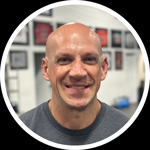3 Coaching Cues to Make Your Strength and Conditioning Programs More Effective
When it comes to strength and conditioning programs, I’ve long been a proponent of the phrase, “It’s not just what you do; it’s how you do it.”
Whenever I visit a commercial gym, I’m reminded of just how badly most people butcher exercise technique. A lot of people get hurt with exercise, and it isn’t necessarily because the exercise is inherently bad, but because their execution of that exercise (or their “intepretation” of it) is grossly flawed.
To that end, I thought it would be a good idea to kick off a new series about coaching cues we regularly use with our clients and athletes. Here are three to get the ball rolling:
1. “Make a double chin.”
I’m a huge advocate of teaching the packed neck during strength exercises, as a lot of athletes have a tendency to slip into forward head posture the second they get under load. However, the common cue of “tuck the chin” really doesn’t work, as a lot of athletes will simply open the mouth or take the chin to the sternum. Neither of these patterns are ideal. Simply telling someone to make a double chin usually fixes the problem instantly, as it’s a pattern that is already in their existing schema; they’ve been making goofy faces every since they were kids.
This is, of course, a cue you might want to avoid if your client does, in fact, have many chins.
2. “Stare at your fists.“
Prone bridges are a tremendously valuable anterior core stability exercise, especially for beginners. Unfortunately – and possibly because they’re so common in group exercise settings – the technique gets butchered all the time, as folks make themselves “too long” with their set-up. When the hands are too far out in front of the body, the challenge improves considerably, and folks often drop into a forward head posture, “buffalo hump” at the thoracic spine, and lumbar hyperextension. Here’s what the poor technique looks like; you’ll see that the athlete is simply training in an excessively lordotic posture:
Here’s how it looks when it’s corrected:
3. “Work like a see-saw.”
I’m a big fan of single-leg deadlifts, but the truth is that a lot of people struggle to master the hip hinge in unilateral stance. One of the quick and easy ways to correct this is to tell an athlete to “work like a see-saw.” In other words, imagine the dumbbell in front as being one side of the see-saw, and your foot in the back as the other end. Since the foot weighs less than the dumbbell, you’ve got to get it further out on the see-saw to have the same counterbalancing effect.
The same is true in the warm-up period, even if you don’t have weights in the hands:
Did you find these tips helpful? Looking for more coaching cues like these? In the comments section below, let me know what exercise technique gives you trouble and we’ll cover it in a future installment!




